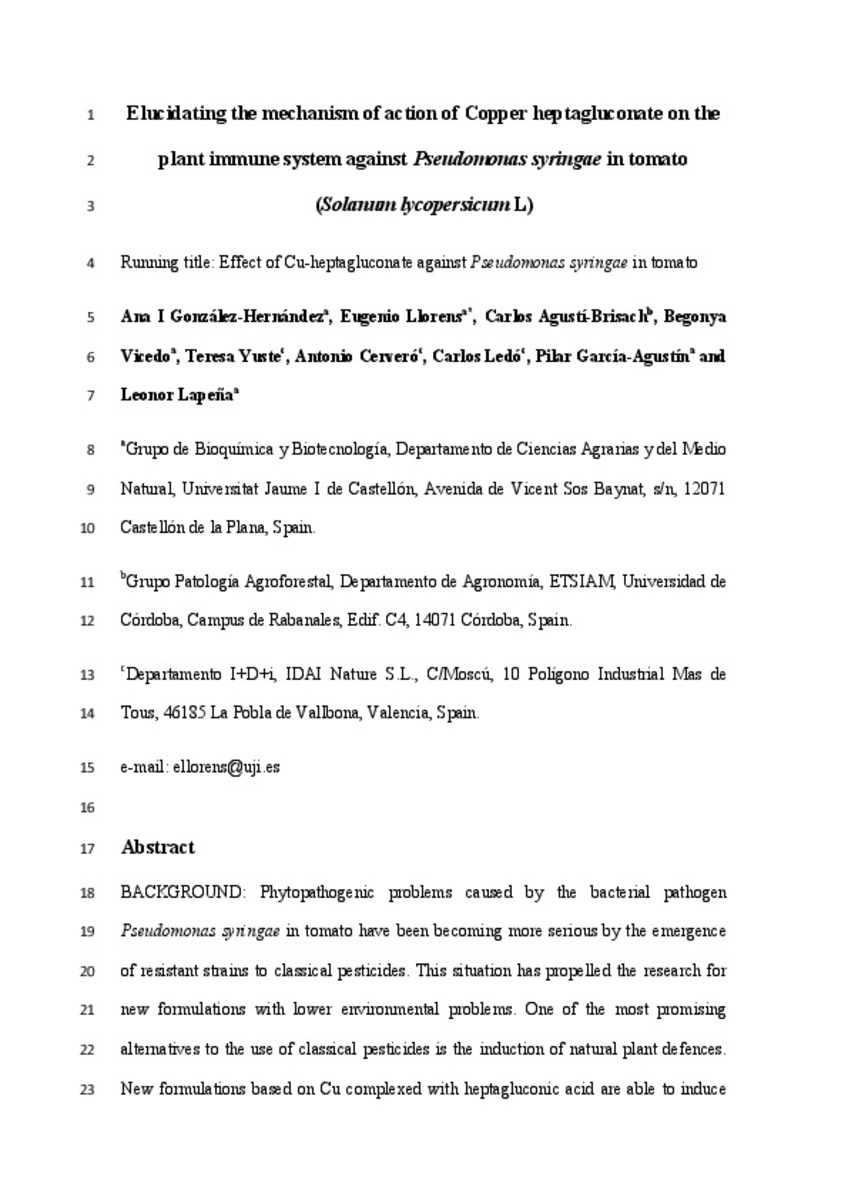| dc.contributor.author | González-Hernández, Ana I. | |
| dc.contributor.author | Llorens, Eugenio | |
| dc.contributor.author | Agustí-Brisach, Carlos | |
| dc.contributor.author | Vicedo, Begonya | |
| dc.contributor.author | Yuste, Teresa | |
| dc.contributor.author | Cerveró, Antonio | |
| dc.contributor.author | Ledó, Carlos | |
| dc.contributor.author | García Agustín, Pilar | |
| dc.contributor.author | Lapeña, Leonor | |
| dc.date.accessioned | 2019-02-11T16:16:17Z | |
| dc.date.available | 2019-02-11T16:16:17Z | |
| dc.date.issued | 2018 | |
| dc.identifier.citation | GONZÁLEZ‐HERNÁNDEZ, Ana I., et al. Elucidating the mechanism of action of Copper heptagluconate on the plant immune system against Pseudomonas syringae in tomato (Solanum lycopersicum L). Pest management science, 2018. | ca_CA |
| dc.identifier.issn | 1526-498X | |
| dc.identifier.issn | 1526-4998 | |
| dc.identifier.uri | http://hdl.handle.net/10234/180957 | |
| dc.description.abstract | BACKGROUND: Phytopathogenic problems caused by the bacterial pathogenPseudomonas syringaein tomato are becomingmore serious due to the emergence of strains resistant to classical pesticides. This has led to research into new formulationswith lower environmental problems. One of the most promising alternatives to the use of classical pesticides is the inductionof natural plant defences. New formulations based on Cu complexed with heptagluconic acid induce plant innate defencesand could be an alternative to classical treatments based on inorganic Cu against bacterial speck. To study the efficacy of thiscompound in tomato againstP. syringae, we tested its systemic effect Applying the treatments via radicular.RESULTS: Treated plants showed less infection development and lower number of viable bacteria in leaves. We also observedbetter performance of parameters involved in plant resistance such as the antioxidant response and the accumulation ofphenolic compounds.CONCLUSION: Results showed that soil drench applications can be highly effective for the prevention and control of bacterialspeck in tomato plants, showing a reduction in symptoms of∼50%. Moreover, application of Cu heptagluconate inducedaccumulation of the plant polyphenols caffeic and chlorogenic acids, and reduced the amount of reactive oxygen species ininfected plants. | ca_CA |
| dc.format.extent | 21 p. | ca_CA |
| dc.format.mimetype | application/pdf | ca_CA |
| dc.language.iso | eng | ca_CA |
| dc.publisher | Wiley | ca_CA |
| dc.relation.isPartOf | Pest Manag Sci 2018, 74 | ca_CA |
| dc.rights | © 2018 Society of Chemical Industry | ca_CA |
| dc.rights.uri | http://rightsstatements.org/vocab/InC/1.0/ | * |
| dc.subject | copper heptagluconate | ca_CA |
| dc.subject | induced resistance | ca_CA |
| dc.subject | Pseudomonas syringae | ca_CA |
| dc.subject | Solanum lycopersicum | ca_CA |
| dc.title | Elucidating the mechanism of action of copper heptagluconate on the plant immune system against Pseudomonas syringae in tomato (Solanum lycopersicum L) | ca_CA |
| dc.type | info:eu-repo/semantics/article | ca_CA |
| dc.identifier.doi | https://doi.org/10.1002/ps.5050 | |
| dc.relation.projectID | FI-NOA/2014/46 ; AGL2013-49023-C3-2-R ; PREDOC/2016/2 | ca_CA |
| dc.rights.accessRights | info:eu-repo/semantics/restrictedAccess | ca_CA |
| dc.relation.publisherVersion | https://onlinelibrary.wiley.com/doi/full/10.1002/ps.5050 | ca_CA |
| dc.date.embargoEndDate | 2019-10-12 | |
| dc.type.version | info:eu-repo/semantics/acceptedVersion | ca_CA |







